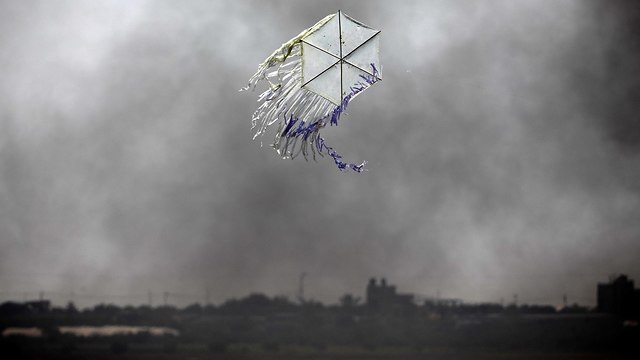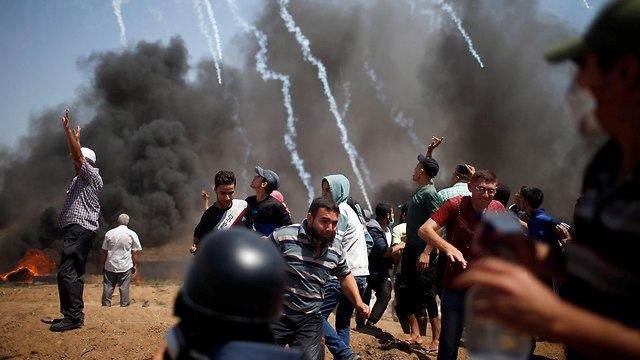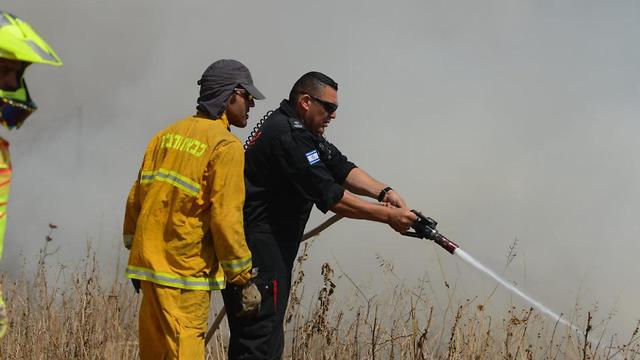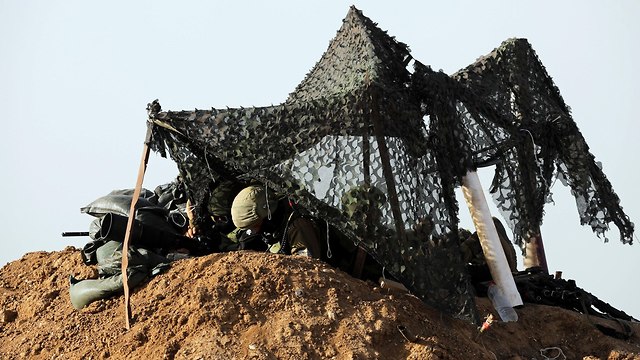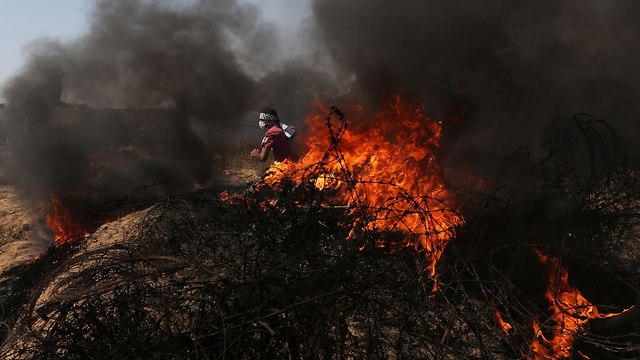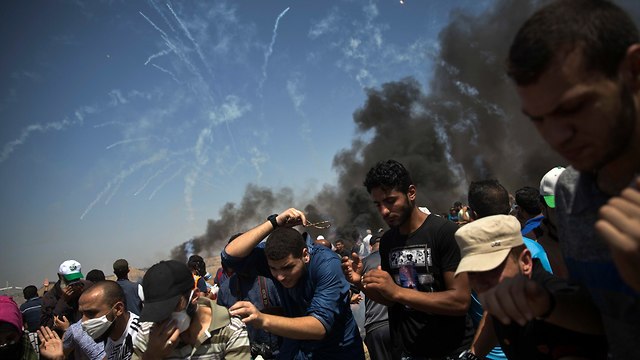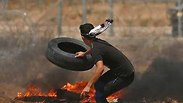
Hamas failed, but the Gaza problem is far from resolution
The terror group called on the masses to storm the border fence on Naksa Day and the last Friday of Ramadan, but got barely 10,000 people there. It's possible the IDF coming out in large forces and the physiological warfare it employed deterred the Palestinians. But even if it seems we can breathe easy now, this is far from over.
On an earth mound facing the fence, some 150-200 meters away, the IDF's snipers were lying in wait, watching what was happening motionless. At that hour, everything was still quiet. Even the kites weren't in the air yet.
This time, the earth mounds located 20 meters from the fence were also populated by large camera crews from the Combat Intelligence Collection Corps and the IDF Spokesman's Unit. This time, the army was determined not just to prevent the crossing of the border, but to also show the protesters up close. Later, those same youths who were standing seemingly peacefully some 100 meters from the border fence behind the barb wire fence the IDF put there, will run to the fence, throw explosives and try, under the cover of the smoke from the tires they'll set ablaze, to get near the border.
Shortly after that, at around 2pm, as if they received a signal, the rioting broke out. Buses brought some 2,000 people—men and women, mostly youths. There were hardly any kids this time. Like the IDF, Hamas has also drawn conclusions from the criticism it suffered in the strip and across the Arab world for sending kids to the front and using them as cover for its attempts to breach the fence. From where I was lying on the earth mound, I couldn't see even one child.
Meanwhile, the sound guy on the Palestinian side turned the volume up to the max and the announcer screeched with all of his might, thundering with a mix of slogans and praise for the "shahid heroes." When he eventually lost his voice, he stopped, and his shouting was replace by war songs as the first of the incendiary kites went up into the air.
Hamas failed in bringing out the masses
On the Israeli side, not far behind me, a drone went up into the air, blew up two kites within a second, and landed back down. The soldiers, who were filming this, started clapping.
The masses started moving towards the border fence, but still didn't dare crossing the barb wire fence. Two teens broke forward and started rolling burning tires in front of the sniper position. The thick black smoke lazily rose higher and higher. Later, other teens came and started rolling tires in front of the snipers as well. One group started running south, trying to get near a different sniper position. An ambulance accompanied them with the whine of its siren—not as a warning for others to make way, but rather to rile up the youths who were running to the fence. The battalion commander ordered the soldiers to fire into the air to deter the youths. A short burst of gunfire, and they stopped.
In the hours I was there—until around 6:30pm when the Palestinian rioters started dispersing—I didn't notice much motivation. On the contrary, the protesters acted almost lazily and only the incendiary kites rose up from the Saja’iyya neighborhood, a few hundred meters from us. The northwestern wind pushed them towards the fields of Nahal Oz. Several of them landed and set fire to dry bushes. The Fire Department was prepared this time, too, and fire trucks from both the Fire Department and the Air Force charged at every blaze. Here, too, the Palestinians had no achievements.
During that time, a roar was heard from the masses gathering outside the Karni border crossing. Several youths ran forward with cutters, cut through the barb wire fence, and made a run for the border fence. The snipers in the position near me had the main instigators' heads in their sights, but didn't shoot. The youths—less than eight in number—ran and hurled pipe bombs and other small explosives at the fence. They were trying to get the soldiers to back away from their positions and cause the snipers duck their heads and then cut through the border fence, as one of the soldiers explained to me.
The battalion commander asked the brigade commander for permission to shoot at the legs of the explosive-throwers. Permission was granted, and one of them fell to the ground, with his friends pulling him back. A Palestinian ambulance sped towards them, loaded up the wounded man, and sped away, disappearing into the alleyways of Saja’iyya.
This spectacle repeated itself, though at a low frequency. It's pretty clear that the Palestinians who charged at the fence were there against their will. The thousands that ran to the fence in spearhead formation on Nakba Day two weeks ago, with Hamas men leading the charge, were nowhere to be seen on Friday. Their entire conduct this week was sluggish, as if done just to fulfill an obligation.
It appears to be the result of several things: Maj. Gen. Eyal Zamir, who planned the troops' deployment before vacating his office this week, drew the right conclusions from Nakba Day—this time the forces were out in large numbers, clearly seen on the other side. There's no doubt this had a deterring effect. There were also more kites shot down using drones than before. The fields around us were filled with dozens, if not hundreds, of kites that crash-landed there.
But it wasn't just the physical warfare that the IDF was well-prepared for this time, the IDF Spokesman was well-prepared for the psychological battle as well, documenting the real nature of the "March of Return"—the demonstrations led by unarmed protesters who were joined by the explosive-throwers and barb-wire-cutters. But there wasn't much to document this time, and that's a good thing.
Hamas failed completely this week. Its calls on the masses to charge the border fence to honor Naksa Day and the last Friday of Ramadan were answered by very few. Barely 9,500 people got to the fence, and around 6pm, as the committees organizing the protest had determined, they left for evening prayers and from there to the Iftar meal.
It's definitely reasonable to determine that the IDF's increased and sophisticated preparations in both the physical and psychological warfare had a deterring effect. The international camera crews who thought there might be a repeat of the bloody events of Nakba Day were proven wrong, and heaved a sigh of relief.
But the Gazan problem has not been resolved. It's there, like a humanitarian abscess and an accumulation of hatred and despair. That is why even if we as Israelis can breathe easy today, we have to know this story is far from over.











